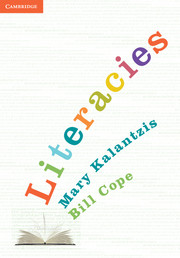Book contents
- Frontmatter
- Contents
- Acknowledgements
- Introduction The work of learning and teaching literacies
- Part A The ‘Why’ of Literacies
- Part B Approaches to Literacies
- Part C The ‘What’ of Literacies
- Chapter 7 Literacies as multimodal designs for meaning
- Chapter 8 Making written meanings
- Chapter 9 Making visual meanings
- Chapter 10 Making spatial, tactile and gestural meanings
- Chapter 11 Making audio and oral meanings
- Part D The ‘How’ of Literacies
- References
- Index
Chapter 11 - Making audio and oral meanings
from Part C - The ‘What’ of Literacies
- Frontmatter
- Contents
- Acknowledgements
- Introduction The work of learning and teaching literacies
- Part A The ‘Why’ of Literacies
- Part B Approaches to Literacies
- Part C The ‘What’ of Literacies
- Chapter 7 Literacies as multimodal designs for meaning
- Chapter 8 Making written meanings
- Chapter 9 Making visual meanings
- Chapter 10 Making spatial, tactile and gestural meanings
- Chapter 11 Making audio and oral meanings
- Part D The ‘How’ of Literacies
- References
- Index
Summary
Overview
Audio and oral meanings share the sense of hearing as the primary medium of perception. Audio meanings range from ambient or background sounds in our environment, to sounds that have symbolic meaning, and to the complex meanings represented in music. Oral meanings carry with them the basic qualities of audio meanings as we modulate volume and pitch in the sounds of speaking. Despite the important connections, there are large and significant differences between the ways in which language is formed in the oral and written modes. These differences are the power that motivates mode-shifting in learning, not just between oral and written meanings, but across the full range of modes of meaning.
Audio meanings
Representation and communication in sound
The human sense of hearing captures sounds that come through air pressure waves. The human ear is capable of detecting loudness in these waves (amplitude) and pitch (frequency). The human capacity to hear is within a very particular range. The upper limits of loudness are defined by the point at which the effect is hearing loss. Low frequencies are also perceptible by touch in the form of vibrations.
- Type
- Chapter
- Information
- Literacies , pp. 303 - 322Publisher: Cambridge University PressPrint publication year: 2012
- 1
- Cited by



